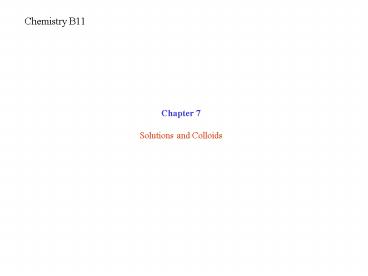Solutions and Colloids - PowerPoint PPT Presentation
1 / 25
Title:
Solutions and Colloids
Description:
Concentration. Molarity (M) = moles solute (n) volume of solution (L) ... Higher concentration Higher osmotic pressure. Osmotic Pressure. Osmolarity (osmol) = M i ... – PowerPoint PPT presentation
Number of Views:661
Avg rating:3.0/5.0
Title: Solutions and Colloids
1
Chemistry B11
Chapter 7 Solutions and Colloids
2
Mixtures
Mixture is a combination of two or more pure
substance.
Homogeneous uniform and throughout Air, Salt in
water
Solution
Heterogeneous nonuniform Soup, Milk, Blood
3
Solutions
Gas in gas (air) solid in solid (alloys)
liquid in liquid (alcohol in water) Gas in
liquid (cokes) solid in liquid (sugar in water)
Solutions Well-mixed (uniform) single
phase homogenous transparent cannot be
separated by filter do not separate on standing
sugar in water
4
Solutions
Solvent greater quantity (water) Solute
smaller quantity (sugar)
5
Solutions
Saturated solvent contains or holds all the
solute it can (at a given T). maximum solute
that solvent can hold (Equilibrium).
Unsaturated solvent can hold more solute (at a
given T). Is not the maximum solute that solvent
can hold.
6
Temperature and Solutions
Solubility the maximum solute can dissolve in a
given amount of solvent (in a given T).
7
Temperature and Solutions
Supersaturated solution
Seeding
A surface on which to being crystallizing.
8
Global Warming
9
Pressure and Solutions
P ?
Henrys law
Solubility ? (gas in liquid)
10
Concentration
Concentration amount of a solute in a given
quantity of solvent.
1. Percent concentration
Weight solute
Weight / volume (W / V)
100
Volume of solution (mL)
Weight solute
Weight / Weight (W / W)
100
Weight of solution
Volume solute (mL)
100
Volume / volume (V / V)
Volume of solution (mL)
11
Concentration
2. Molarity (M) number of moles solute dissolved
in 1 L of solution.
moles solute (n)
Molarity (M)
volume of solution (L)
Molarity V number of moles (n)
prepare the solution M, V ? n (mol) ? m (g)
12
Concentration
3. Parts per Million (ppm)
g solute
ppm
106
g solvent
Parts per billion (ppb)
g solute
ppb
109
g solvent
13
Dilution
M1V1 moles(n) before dilution M2V2
moles(n) after dilution
M1V1 M2V2
V1 V2
14
Water in our body
- About 60 of our body.
- Most of the reactions occur in aqueous solution.
- Participates in biochemical reactions.
- Transports reactants and products from one place
in our - body to another.
- 5. Eliminates wastes material from cells and our
body (urine).
15
Solvent and Solute
polar dissolves polar Nonpolar dissolves nonpolar
like dissolves like
16
Solvent and Solute
All nitrates (NO3-) and acetate (CH3COO-) are
soluble in water.
Most chlorides (Cl-) and sulfates (SO42-) are
soluble in water (except AgCl, BaSO4 and )
Most carbonates (CO32-), phosphates (PO43-) and
hydroxides (OH-) are insoluble in water.
(except NaOH, LiOH, KOH and NH4OH)
17
Electrolytes
bulb
Electrolyte conduct an electric current.
Na
Cl-
Ionization
NaCl ? Na Cl-
strong electrolytes molecules dissociate
completely to ions (NaCl). weak electrolytes
molecules dissociate partially to ions
(CH3COOH). nonelectrolytes molecules do not
dissociate to ions (DI water).
18
Colloids
Solutions diameter of particles is under 1
nm. Colloids diameter of particles is between 1
to 1000 nm.
non transparent, non uniform, large particles,
cloudy (milky) but stable system
19
Colloids
Tyndall effect You can see the light passes
through a colloid. (particles scatter light.)
20
Brownian motion
Random motion of colloid particles.
Dust
Why do colloidal particles remain in solution and
do not stick together?
1. Surrounding water molecules prevents colloidal
molecules from touching and sticking together.
2. Colloidal particle encounters another particle
of the same charge, they repel each other.
21
Freezing and boiling point
bp ? fp ?
If we dissolve a solute in a solvent
?T change of bp or fp (T2 - T1) i number of
particles K constant (depend on solute) Kb
Kf M molarity
?T ikM
NaCl ? Na Cl-
i 2
K2SO4 ? 2K SO42-
i 3
C2H6O2
i 1
22
Osmotic Pressure
osmotic pressure
Semipermeable membrane
Higher concentration ? Higher osmotic pressure
23
Osmotic Pressure
Osmolarity (osmol) M i
M molarity i number of particles
Osmolarity ? ? Osmotic pressure ?
24
Isotonic solution
Hypotonic solution
Hypertonic solution
Hemolysis
Crenation
25
Dialysis
Dilute solution

